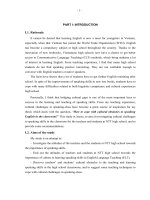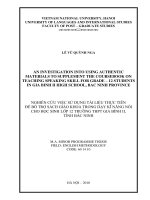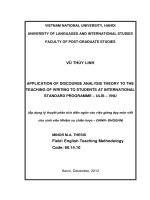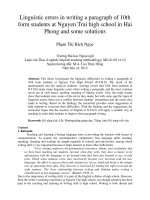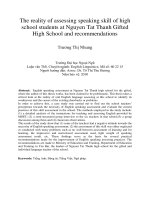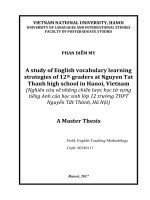The reality of assessing speaking skill of high school students at Nguyen Tat Thanh Gifted High School and recommendations
Bạn đang xem bản rút gọn của tài liệu. Xem và tải ngay bản đầy đủ của tài liệu tại đây (262.38 KB, 9 trang )
The reality of assessing speaking skill of high
school students at Nguyen Tat Thanh Gifted
High School and recommendations
Trương Thị Nhung
Trường Đại học Ngoại Ngữ
Luận văn ThS. Chuyên ngành: English Linguistics; Mã số: 60 22 15
Người hướng dẫn: Assoc. Dr. Tô Thị Thu Hương
Năm bảo vệ: 2010
Abstract: English speaking assessment at Nguyen Tat Thanh high school for the gifted,
where the author of this thesis works, has been claimed to be problematic. This thesis takes a
critical look at the reality of oral English language assessing at this school to identify its
weaknesses and the causes of the existing drawbacks or problems.
In order to achieve this, a case study was carried out to find out the school teachers’
perceptions towards the necessity of English speaking assessment and evaluate the current
practices of this skill assessment in the school. The methods employed in the study include:
(1) a detailed analysis of the instructions for teaching and assessing English provided by
MOET; (2) a semi-structured group interview to the six teachers in that school;(3) a group
discussion among them and (4) classroom observations.
The results of the study show that (1) some of the teachers had a negative attitude towards the
necessity of English speaking assessment; (2) the assessment of this skill was either neglected
or conducted with many problems such as no wall between assessment of learning and for
learning, the impressive and norm-based assessment used, light weight of speaking
assessment result, etc. These findings serve as the basis for several practical
recommendations made for the improvement of English speaking assessing practices. The
recommendations are made to Ministry of Education and Training, Department of Education
and Training in Yen Bai, the leaders of Nguyen Tat Thanh high school for the gifted and
individual language teacher of the school.
Keywords: Tiếng Anh; Động từ; Tiếng Việt; Ngữ pháp.
6
Content:
TABLE OF CONTENTS
Declaration…………………………………………………………………………
Acknowledgements………………………………………………………………
Abstract…………………………………………………………………………….
Abbreviations ……………………………………………………………………
Table of contents … ………………………………………………………………
PART A. INTRODUCTION… ………………………………………………
1. Rationale…………………….……………………………………………….
2. The study aims……………………………………………………………….
3. Research questions ………………………………………………………….
4. Method of the study …………………………………………………………
5. Scope of the study……………………………………………………
6. Design of the study………………………………………………………….
PART B. DEVELOPMENT……………………………………………………
Chapter 1. Literature review……… …………………………………………
1.1. Language assessment ……………………………………………………
1.1.1. Language assessment vs. language testing…………………………
1.1.2. Types of language assessment………………………………………
1.2. Speaking assessment…… ………………………………………………
1.2.1. Nature of speaking …………………………………………………
1.2.2. Preliminary considerations of English speaking assessment………….
1.3. Previous researches on assessment of speaking skill ………………………
Chapter 2. The study….………………………………………………………
2.1. Research questions………………………………………………………
2.2. Methodology………………………………………………………………
2.2.1. Case study……………………………………………………………
2.2.2. Contextual factors affecting the practice of speaking assessment…….
2.2.2.1. The case of Nguyen Tat Thanh Gifted High school…………….
2.2.2.2. Syllabus approach to English speaking teaching and assessing…
2.2.3. Data collection………………………………………………………
i
ii
iii
iv
v
1
1
2
3
3
4
4
5
5
5
5
6
7
7
9
11
14
14
14
14
15
15
15
16
7
2.2.3.1. Participants………………………………………………………
2.2.3.2. Procedures……………………………………………………….
2.2.4. Methods of data analysis……………………………………………
Chapter 3. Results of data analysis and discussions………………….………
3.1. Semi-structured group interview ………………………………………….
3.1.1.Teachers’ perception towards the necessity of English speaking
assessment
3.1.2. Unsound practices of English speaking skill assessment… …………
3.2. Group discussion………………………………………………… ………
3.3. Classroom observation……………………………………………………
PART C. CONCLUSION…………………………………………………….……
1. Conclusions of the study………………………………………………………
2. Suggestions for assessing English speaking skill in upper secondary school…
3. Limitation of the research ………………… ………………………………….
4. Suggestions for further study……………………………… ………………….
REFERENCES…………………………………………… ……………………
APPENDICES
Appendix 1. Guided questions for the semi-structured group interview……
Appendix 2.
T
he instructions for teaching and assessing English
provided by MOET ……………………… ………………….
Appendix 3. Group discussion transcripts and translation…… …………….
17
17
19
20
20
20
23
29
30
33
33
34
38
38
39
40
I
IV
VI
8
PART A. Introduction
1. Rationale:
In Vietnam, there have long been heated discussions about the English competence
of Vietnamese people. The Vietnamese are often described as having no ability to
communicate in English. A typical example of this was published in Viet bao (Viet
bao.com.vn -12.10.2006), Tin tuc 24/7 (tin247.com.vn-13.10.2006). The article by Kim
Lien discussed why the majority of Vietnamese high school students after having learnt
English for 7 years in school could not use English to communicate with foreigners. One of
the main reasons provided was that the current English tests in the curriculum did not focus
on assessing communicative skills, thus, teaching practices which were always test-
oriented also neglected speaking and listening skill. The article was issued 4 years ago but
it has pointed out the key factor which caused the poor quality of English learning in
general and Vietnamese students’ inability to communicate in English in particular being
negative washback effects of official tests, low proficiency of teachers and negative
attitudes toward speaking English.
Since then much effort has been spent on improving Vietnamese students’ ability to
communicate in English. The most significant solution can be the implementation of the
new series of English books for secondary high school which claimed to be based on
communicative approach and not only focus on the language elements as the old ones did
but also develop all the four macro language skills. Another big solution would be the
Prime Minister’s approval of one big project called “Teaching and learning foreign
languages in the national English education system in the period 2008-2020”. The project
aims at renewing teaching and learning of foreign languages in Vietnam. The significance
of the project lies in the adoption of a new language assessment standards and framework,
the Common European Framework for Language Reference (CEFR) for assessing English
language ability of Vietnamese learners.
However, the question is that once the new textbooks have been implemented, the
teaching approach has changed, the new assessment framework has been introduced,
whether there are any positive changes in assessing interaction skills which include
assessing listening and speaking skill. The question remains unanswered empirically.
9
The researcher has been unsuccessful in finding researches done on speaking
assessment in high schools of Vietnam. As a teacher of English, the researcher is eager to
find the answer to this question. Firstly, she would like to study how speaking and listening
were assessed in her school. However, with a very early look at the situation of the school,
she soon realized although all the four skills were taught to the students, students’ listening
skill was not assessed and speaking skill was assessed to some extents but with many
problems. Consequently, she decided to do research on investigating how English speaking
assessment was conducted at her school. The research was entitled “The reality of
assessing speaking skill of high school students at Nguyễn Tất Thành gifted high school
and Recommendations.”
The research was conducted in the context of a high school for gifted students in a
mountainous area. The students in the school have a higher level of English than students
in other schools in the province. No students with the English score at the school entrance
examination lower than 4 can enter the school. Besides, 95 % of the school leavers
succeeded in university entrance exam in 2009 and some students has won scholarship for
foreign study. Thus, the students do not only learn English grammar and vocabulary for the
graduation exam but they also see the importance of speaking skill. The size of the class at
the school is much smaller than that of a normal one. All the above-mentioned factors
seem to be advantageous to teaching English speaking in general and the application of the
skill assessment in particular. In the context of this school, English speaking assessment,
therefore, should be done and needs to be done appropriately. However, the reality appears
to be not perfect. This also adds one more reason to the rationale of this research.
Overall, the researcher hopes that this study would provide a closer look at the
speaking assessment in everyday classroom situation; thus, it would be helpful to not only
the researcher herself in making better teaching decisions in her classes but also to the
school administrators and policy makers for further improvement of English teaching and
learning.
2. The study aims:
With the above rationale, the two main aims of this research are:
- to find out the problems emerging during the process of assessing English speaking
skill in the school context.
- to propose some practical solutions to the problems.
10
To achieve these aims, some specific objectives were defined as follows:
- to investigate the high school teachers’ perception toward the necessity of English
speaking assessment.
- to study the purposes and methods of English speaking assessment, the uses of
assessment data.
- to identify the problems arising in the speaking assessing procedure
- to offer some recommendations on solutions to the problems.
3. The research questions:
With the aims stated above, the researcher proposed three following research questions for
the study:
1. What are the perceptions of Nguyen Tat Thanh gifted high school teachers of English
on the necessity of English speaking assessment?
2. What are the problems emerging during the assessing process?
3. What are the approaches to tackle the problems?
4. The method of the study:
The research was conducted as a case study. This research method was chosen for
the following reasons. Firstly, the research stresses on investigating the reality of speaking
assessment in a high school context; thus, we need an in-depth study on how speaking
assessment is actually done. Besides, because it involves the data from teachers’
perspectives only, an in-depth study then becomes manageable. Finally, the object of the
study is speaking assessment conducted in a school for gifted students so it has a clear
boundary differentiating it from that of normal schools.
This study employed qualitative data collection instruments which included semi-
structured group interview, group discussion and class observation.
The semi-structured group interview was conducted with some guided questions. The
interviewees were also given the guided questions before hand in the form of a handout for
better preparation of ideas and thoughts. Because the questions gathered information of a
rather unfamiliar topic to the teachers and it involved a great recall of assessing
experiences in the whole academic year, the teachers obviously needed time to prepare.
The questions also kept the interviewer as an inexperienced researcher from losing tract.
Then a group discussion was held involving orally assessing one videotaped speech
made by one non-English major student of this school. The teachers were asked to give
11
comments and marks for the presentation. They were also encouraged to discuss the
differences in their assessing practice.
Last but not least, class observation was employed to provide triangulated data. The
class observation may identify gaps between what the teachers say in the interview and
what they actually do in class. The lessons observed were chosen randomly because the
researcher prefers a real picture of speaking assessment. Besides, the speaking assessment
can be conducted in any lesson, not only in speaking lesson.
5. The scope of the study.
This is a minor descriptive study; thus, a number of issues would be beyond the
scope of enquiry. For example, the students’ perceptions of speaking assessment would
not be the study’s concern. The study will not focus on investigating the validity, reliability
and authenticity of the speaking assessment because these are the centre issues in speaking
tests situation rather than speaking assessment in everyday classroom. Especially, the
appropriateness of speaking assessment tasks will be left for further research.
6. The design of the study
The thesis was designed in three parts. Part A is The introduction. It provides a brief
overview of the study with more details of the rationale, the aims, the scope, the research
methodology as well as the design of the study.
Part B, the Development, consists of three chapters. Chapter 1 reviews the literature
in the field of assessment. This chapter presents the theoretical background of the thesis
which contains three main points: language assessment in general, speaking assessment in
particular and some of the previous researches on assessments of English speaking skill.
Chapter 2, namely The study, focuses on the method of the study, the contextual
factors of the case school and the data collection instruments and procedure.
The next chapter, chapter Three, represents not only a detail description of data
analysis but also the discussion of the findings. Chapter 3 is divided into three parts dealing
with the data collected through three instruments: interview, discussion and observation.
Part C, The conclusion, is devoted to the conclusions of the studies. It summarizes
the problems associated with English speaking assessment and provides some
recommendations to cope with the identified problems. In this part, the researcher also
mentions the limitations of the study and some recommendations for further study as well.
46
References
1. Bachman, L. F. & Palmer, A. S. (1996). Language Testing in Practice. Oxford: Oxford
University Press.
2. Brown, D.H. (2001). Teaching by Principles, New York: Pearson Education Limited
3. Brown, D.H. (2004). Language Assessment: Principles and Classroom Practices.
United State of America: Pearson education, Inc.
4. Brown, K. L. (1981). Teaching, Speaking and Listening skills in the Elementary
and Secondary School. Boston, MA: Massachusetts Department of Education.
5. Chalhoub-Deville, M. & Deville, C. (2005). A look back at and forward to what
language testers measure. In E. Hinkel (ed.), Handbook research in second language
teaching and learning. Mahwah, NJ: Lawrence Earlbaum.
6. Delors. J, et al. (1996). Learning: the treasure within. Paris: UNESCO. (Report of the
International Commission on Education for the Twenty-first Century).
7. Do, H.N. (2006). The reality of English assessment to Grade 6 students at Ho Chi Minh
city. Conference proceedings of the 2006 conference on Assessments to promote the
activeness of secondary school students, Ho Chi Minh city, Vietnam.
8. Flick, U. (1998). An introduction to qualitative research. In Halai, N. (2007) Making
Use of Bilingual Interview Data: Some Experiences from the Field. The Qualitative
Report Vol. 12, No. 3, September 2007 (344-355).
9. Fulcher, G. (2003). Testing Second Language Speaking. London: Pearson
Longman.
10. Ho, D.H.M. (2006). The results of an experimental study on English assessment to
Grade 6 students at Ho Chi Minh city. Conference proceedings of the 2006 conference
on Assessments to promote the activeness of secondary school students, Ho Chi Minh
city, Vietnam.
11. Genesse, F. & Hamayan, E.V. (1991). Classroom-based Assessment. In F. Genesee,
(ed.), Educating Second Language Children: The Whole Child, the Whole Curriculum,
the Whole Community. New York: Cambridge University Press.
12. Genesee , F., & Upshur, J. A. 1996. Classroom-based evaluation in second language
education. Cambridge: Cambridge University Press.
47
13. Greer, T. (2003). Transcription approaches to multilingual discourse analysis.
Conference proceedings of the 1997 symposium Jalt Pan- SIG conference, Kyoto,
Japan. Retrieved May 29, 2004, from
14. Kim H. S. (2003). The types of speaking assessment tasks used by Korean Junior
Secondary school English teachers. Asian-EFL-Journal December 2003 Articles.
15. Kim, L. (2006) Why can’t Vietnamses students speak English after 7 years learning
this subject at school? Tin tuc 24/7 Retrieved October,13 2006, from:
nam hoc%2C tai sao khong biet noi tieng anh-11-
21297102.html.
16. Ministry of Education and Training. (2007), English 11, Teacher manual book. Hanoi:
Education Publisher.
17. Ministry of Education and Training. (2006). The English curriculum for higher
secondary school (2009-2010). Guideline document delivered to teachers of Yen Bai
by MOET.
18. Le, N (2008). Oral Language Testing at Tay Nguyen University. Retrieved February
24, 2008, from:
19. Linda G. Morra Imas, Ray C. Rist (2009) The Road to Results: Designing And
Conducting Effective Development Evaluations. Washington, DC: World Bank
Publications.
20. O'Malley, J. M., & Pierce, L. V. (1996). Authentic assessment for English language
learners: Practical approaches for language teachers . Reading, MA: Addison-
Wesley.
21. Rea-Dickins, P. (2000). Classroom assessment. In Hedge, T. Teaching and Learning
in the Language Classroom. Oxford: Oxford University Press.
22. Stake, R. E. (1995). The Art of Case Study Research. London: Sage Publications.
Available at www.ideas-int.org/documents/Document.cfm?docID=149
23. Richard J. S. (2005). Student-Involved Assessment FOR Learning 4
th
. Pearson
Education, Inc.
24. Tran, T.L. (2006). What are the objectives of English assessment at Vietnamese high
school? Conference proceedings of the 2006 conference on Assessments to promote
the activeness of secondary school students, Ho Chi Minh city, Vietnam.
